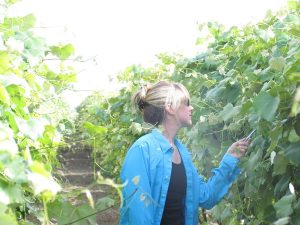If you’ve ever packed fruit snacks in a lunch, enjoyed a glass of grape juice, or made a PB&J, chances are the grapes used in those products were grown in Washington’s Yakima Valley. That’s because household brands like Welch’s Smucker’s, and Tree Top get most of their grapes from Washington state, the largest producer of the Concord grapes in the nation.
But growers of your favorite childhood (and adult) Concord classics are fighting iron chlorosis, a pervasive and destructive disease that threatens Concord grapevines throughout the state. Conventional management tools like foliar applications have proven labor intensive and cost prohibitive, leaving many affected growers with few if any options.

While researching soil microbes beneath chlorotic and non-chlorotic grapevines, WSU assistant professor and soil microbiologist, Tarah Sullivan, found a link between microbial communities in the grapevine’s rooting zones and chlorosis, suggesting there might be a more sustainable, bottom-up solution in store.
Stemming from a chlorophyll deficiency, chlorosis is often easy to identify by its yellowing-effect on leaves and vines, but its specific causes can be more difficult to pinpoint, especially if growing conditions are the same, vineyard-wide.
“You can have this very homogenous soil type, and very flat land,” Sullivan said. “It’s all irrigated the same way, and with the same water. And yet, you have a series of healthy vines, then one sick vine, and more healthy ones, and so on.”
What Sullivan wants to know now is what accounts for these differences.
Along with Joan Davenport—a now-retired WSU soil scientist with three decades experience studying grapevine chlorosis—Sullivan began field trials in 2016. One striking discovery was that among the fungal communities there weren’t any clear differences related to chlorosis.
“But when we got into the bacterial community, we found a really strong pattern,” Sullivan said.
The researchers correlated over two dozen bacterial families to healthy vines, while linking three particular bacterial families to vines with chlorosis.
Then Sullivan made a significant discovery. After a grapevine’s rooting system secretes acids into its rhizosphere enabling it to better absorb iron, certain microbes can express genes that allow them to “cheat,” or steal available iron from the grape rooting system for the benefit of the microbe, potentially making the plant vulnerable to chlorosis.

“Chlorosis is a serious problem that affects many Concord vineyards in Washington,” Davenport said.
One grower Sullivan worked with was faced with such a severe case of chlorosis, he was forced to uproot an entire vineyard and replant it with watermelon. Such actions can seriously impact a grower’s bottom line.
Taking their discovery to the next level, Sullivan and Davenport started introducing cover crops such as barley, wheat, rye, and a vetch-wheat combination to vineyard floors to fortify soil health. The initial tests produced mixed results.
“We found that microbial communities definitely flourished under cover crops,” Sullivan said. “But they didn’t have much effect on chlorosis.”
Still, there was room for optimism.
“Our work did show some positive impacts from the vetch cover crops,” Davenport said. Vetch, a legume related to the pea, is a spindly, flowering plant often used as fodder for cover crops.
“I am very hopeful that the work Dr. Sullivan has proposed will further support these efforts.”
Davenport isn’t the only one who wants to see Sullivan’s work continue. The Washington State Concord Research Council has just funded Sullivan for continued research, ensuring, Sullivan hopes, that our PB&J, grape juice, and fruit snacks remain iconic, sustainable, and affordable.
MEDIA CONTACT: Dr. Tarah S. Sullivan, assistant professor, Department of Crop and Soil Sciences, 509-335-4837, t.sullivan@wsu.edu

